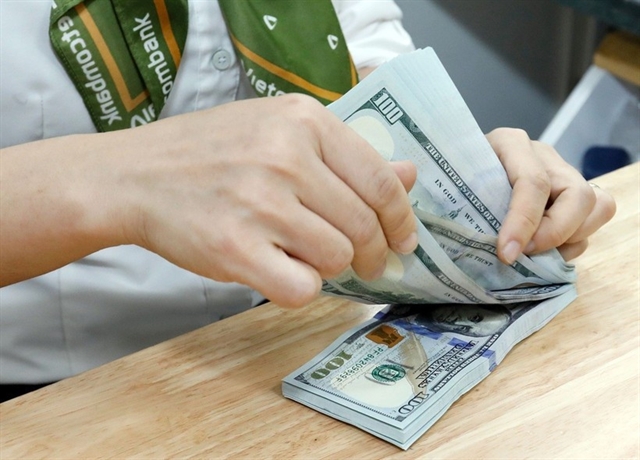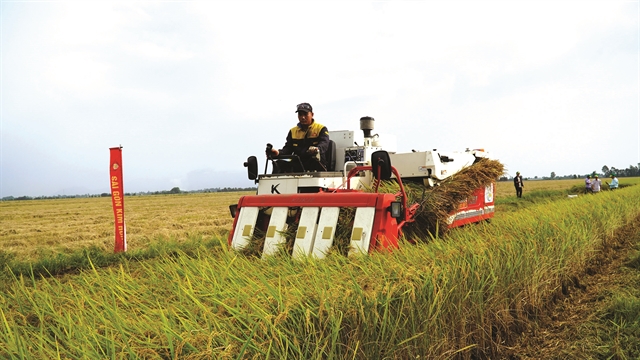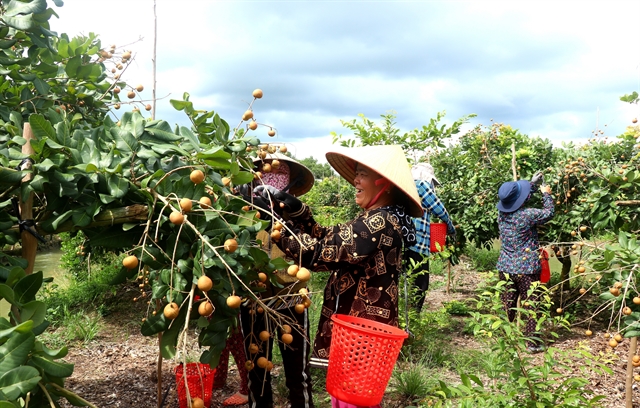 Society
Society


|
| The one-million-hectare high-quality, low-emission rice programme, launched in November 2023, spans 12 provinces in the Mekong Delta. It aims to promote sustainable, premium production of the grain, while cutting greenhouse gas emissions. VNA/VNS Photo |
MEKONG DELTA - In recent years, the Mekong Delta region has continued to assert its position as a cornerstone of the national economy, contributing up to 31 per cent of the agricultural sector’s GDP with its strengths in rice and fruit cultivation as well as aquaculture. At the same time, the region’s agriculture is undergoing a dynamic transformation amid global integration, embracing the worldwide shift towards green consumption.
In 1975, the Mekong Delta had just over two million hectares of rice cultivation land, mostly single-crop lowland rice with modest productivity, yielding only 5–7 million tonnes per year. Although the country was unified, the ravages of war had taken a heavy toll, and Việt Nam still had to import more than two million tonnes of food annually.
Today, half a century after Reunification Day, rice yields in the delta have surged from 5–6 million tonnes in 1977 to more than 20 million tonnes annually. Việt Nam’s rice production and exports are now part of a global value chain.
This April, Tiến Thuận Co-operative in Thạnh An Commune, Vĩnh Thạnh District, stands out as a model in Cần Thơ’s implementation of the one-million-hectare rice scheme, with its lush green 50-hectare paddy fields emblematic of sustainable development.
The one million hectare high-quality and low-emission rice programme was launched in November 2023. The project, implemented across the 12 provinces in the Mekong River Delta, aims to promote sustainable, high-quality rice production and reduce greenhouse gas emissions.
Director of the co-operative Nguyễn Cao Khải told Voice of Vietnam online that adopting practices under the one-million-hectare programme has helped farmers reduce seed, fertiliser and pesticide use while boosting yields, improving quality, and increasing profits compared to traditional methods.
“Profits from circular farming models are two to six million đồng (US$77–232) higher per hectare compared to conventional methods. I’ve cut costs and reduced pesticide applications by two to three times. This results in more stable products than those grown through traditional practices,” Khải said.
Alongside rice cultivation, a shift in mindset towards sustainable agricultural development has enabled fruit products such as longan and mango from Cờ Đỏ District, Cần Thơ City, to reach overseas markets including the US, Australia, Japan, Thailand, the EU, China, South Korea and many others.
Trần Phước Sơn, who heads the Trạng Tí Garden Fruit Co-operative in Cờ Đỏ, said that the co-operative prioritises quality and brand building to enhance competitiveness.
“We always focus on quality—when it’s good, businesses will come to us. That’s why we’re committed to building a brand and maintaining quality to secure product contracts. If we want our goods to compete, there’s no other way but to innovate, produce cleanly and ensure safety and taste,” Sơn said.
More than five hectares of longan cultivated according to VietGAP standards for export to the United States and Australia have brought in hundreds of millions of đồng per harvest for the family of farmer Nguyễn Hoàng Anh in Thới Hưng Commune, Cờ Đỏ District. By adhering to strict cultivation protocols, the family’s produce now fetches premium prices, with no more worries about finding a market, as in years past.

|
| Workers harvest longan for export in Thới Hưng Commune, Cờ Đỏ District, Cần Thơ City. VNA/VNS Photo |
“Each market has different requirements. If you want to enter the US, you have to focus on quality; if it’s Europe, then follow VietGAP standards. You need to be part of a co-operative and comply with the process to export to these markets,” Hoàng Anh said.
Cờ Đỏ is one of the largest fruit-growing areas in Cần Thơ, covering around 5,000 hectares, and is home to many speciality fruits exported to the US, Australia, Japan, the EU and China. Local farmer Phạm Tấn Tài cultivates organic longan for the European market. If the product earns consumer trust, it could open up a new, stable direction for farmers and further boost the region’s agricultural brand.
“Organic farming means enriching the soil with organic matter. It brings countless benefits—organic substances and microorganisms help loosen the soil and improve its structure, so roots absorb nutrients better. Now that I’ve signed a contract to export to the US, the price is naturally higher, and our livelihoods are looking up,” said Tài.
Sustainable cultivation
Farmer Trịnh Văn Khôn, from Trung An Commune, Cờ Đỏ District, has attended training courses on sustainable rice production and emissions reduction. He has since come to see the benefits of these practices, including lower seed, fertiliser and pesticide use—all of which contribute to environmental protection and reduced greenhouse gas emissions in agriculture.
“I’ve been farming for decades, and I can say sustainable, low-emission rice production is truly beneficial for farmers. At first, though, we needed proper training to understand it and put it into practice,” Khôn reflected.
Traditionally, rice farmers sowed 100-120kg of seed per hectare—sometimes as much as 150kg. This practice placed a strain on the environment and increased the risk of disease outbreaks. Under the one-million-hectare rice initiative now being expanded across the Mekong Delta, seed use has been halved, fertiliser use cut by 30 per cent, and chemical spraying significantly reduced.
Director of the Mekong Delta Rice Institute Dr Trần Ngọc Thạch noted that, to reduce emissions in rice farming, the amount of seed must be minimised. Yields remain stable even with just 60–70kg of seed per hectare. The institute’s pilot plots show that yields can still be maintained with only 40kg/ha, proving that reduced seeding doesn’t mean reduced productivity.
However, the success of such practices depends heavily on field conditions and the use of row or clump sowing methods to enhance mechanised efficiency.
“We need varieties that branch early to suppress weeds and allow efficient use of nitrogen fertilisers. Future rice breeding must focus not only on traditional quality traits but also early tilling, low emissions and effective nitrogen use,” Dr Thạch emphasised.
Agriculture, particularly in the Mekong Delta, continues to uphold its foundational role in the national economy. It guarantees a steady supply of food and essential commodities for domestic consumption, ensures national food security and contributes to economic growth, exports, employment and rural livelihoods.
Each year, An Giang Province cultivates around 600,000 hectares of rice, producing roughly four million tonnes—second only to another Mekong Delta province in rice output.
According to Tôn Thất Thịnh, Deputy Director of An Giang’s Department of Agriculture and Environment, rice growing is a key economic sector for the province. An Giang has introduced various measures to enhance the rice value chain, from technology investment to more efficient production methods. However, climate change, salinity and drought have all affected local production. In response, the province is focusing on climate-adaptive, low-emission rice farming and expanding production–consumption linkages to improve farmers’ livelihoods.
“We’re promoting a shift to climate-resilient, low-emission rice farming by building sustainable value chains and strengthening ties between production and consumption. The overall aim is to improve livelihoods for rice farmers,” Thịnh noted.
In the global context, low-emission farming is now a necessity. As Việt Nam rolls out the one-million-hectare rice project in the Mekong Delta, the country is turning its COP26 commitments into concrete action—cutting emissions and protecting the environment.
After observing Việt Nam’s low-emission rice cultivation practices, Li Guo, a senior agricultural economist at the World Bank, stated that the one-million-hectare project in the Mekong Delta will boost incomes, enhance competitiveness and help reduce greenhouse gas emissions. The World Bank is committed to supporting Việt Nam in implementing and scaling up the programme.
“This initiative has three main goals: first, to increase income for rice farmers; second, to enhance the competitiveness of Việt Nam’s rice value chain; and third, to contribute to addressing climate change challenges both domestically and globally,” Li Guo said. VNS